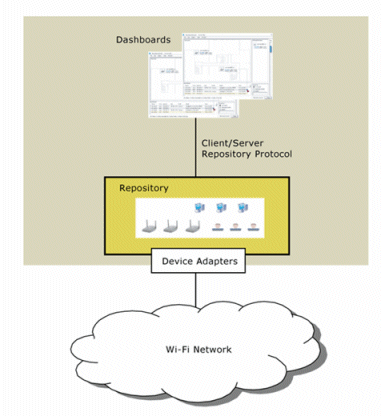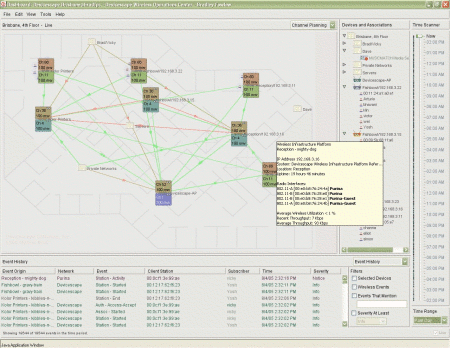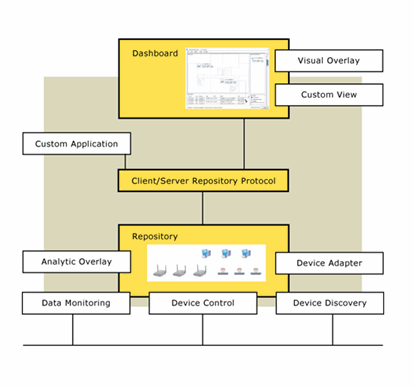WiFi stack vendor adds help desk support tools
Aug 8, 2005 — by LinuxDevices Staff — from the LinuxDevices Archive — views[Updated Aug. 16, 2005] — DeviceScape is shipping a Java-based software suite aimed at assisting corporate help desks in supporting wireless users. WOC (Wireless Operations Center) provides a visual view of wireless infrastructure, making it easier for support staff to resolve common problems, the company says. An extensible OEM version helps WLAN equipment vendors differentiate their products, according to the company.
DeviceScape, formerly Instant802, is best known for its commercial WiFi stacks targeting device vendors adding 802.11 functionality to their embedded devices, including those based on Linux. WOC is the company's first product that targets wireless help desks, however.
WOC has a Java-based server software component that runs on J2SE 1.5 compatible server OSes, such as Red Hat, Debian, or Windows NT or XP, the company says (J2SE 1.5 is not officially supported in Debian, due to license incompatibilities, but can be installed as an add-on with some effort). WOC also includes J2SE 1.5-based “Dashboard” client software and that supports Linux or Windows clients, and can be launched within a browser using Java Web Start technology.

WOC comprises a Java-based “Repository” server, and Java-based “Dashboard” clients
According to DeviceScape, WOC provides a visual view of wireless infrastructure that makes it easier to resolve the most common help requests related to wireless access. The software shows access point location, health, channels, power, signal propagation, RF coverage, interference, and proximity to rogue access points, and can summarize access point and user activity, roaming, history, and throughput, the company says. A “time machine” feature displays “the complete state of the network at any point in the past through the present,” the company claims.

WOC's Dashboard client provides a highly visual view of wireless infrastructure
(Click to enlarge)
According to DeviceScape, WOC works with switches, routers, and servers supporting generic SNMP MIBv2 (management information base), as well as access points that include:
- Those supporting standard 802.11 MIBs
- Those based on DeviceScape's software stacks
- Cisco Aironet access points based on IOS or VxWorks
- Proxim Orinoco access points
Additionally, an extensible version of WOC is available to WLAN OEMs, including those building devices based on embedded Linux. The OEM version, formerly known as Conductor Help Desk, has a message-driven architecture, and allows device makers to differentiate their products by adding management and monitoring features such as additional Dashboard views, DeviceScape says.

WOC for OEMs has a message-driven architecture
WOC can scale to enterprise deployments with hundreds of access points and thousands of concurrent users, DeviceScape says, and is used by wireless service provider NTT-Broadband Platform (NTTBP), which maintains a network of hotspots in Tokyo's metropolitan railway system. NTTBP uses the software to “detect trends that affect network performance before users call to complain,” and says that other WLAN management tools “lack the means to monitor overall activity trends,” explains DeviceScape. A case study about NTTBP's use of WOC is available here (PDF download).
WOC complements other network management tools, DeviceScape says, and requires no reconfiguration or integration with existing systems. CEO Dave Fraser said, “[WOC] is complementary to existing network management systems, greatly enhancing their ability to help companies manage the exploding popularity of wireless networks.”
IDC's senior research analyst of network and service management, Vincent Lui, said, “The ability for support staff to identify overall system problems and support users on a wireless network has thus far been a highly manual process. A help desk system that automates these activities will be a welcome complement to traditional network management systems.”
Availability
WOC is available now, priced at $100 per managed access point for up to 10 APs, with various volume discounts. At 400 APs the pricing is $50, according to the company. An evaluation version is also available for download (registration required).
This article was originally published on LinuxDevices.com and has been donated to the open source community by QuinStreet Inc. Please visit LinuxToday.com for up-to-date news and articles about Linux and open source.